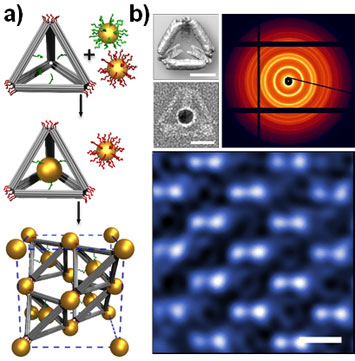Realizing Diamond-Shaped Nanoparticle Superlattices
February 1, 2016

a) Illustration of the approach used to fabricate a diamond superlattice with gold nanoparticles and DNA. b) Experimental results. Upper-left: cryo-TEM density map of a DNA tetrahedron and a negative-staining TEM image of a DNA caged particle (scale bars, 20 nm). Upper-right: SAXS pattern of the diamond superlattice. Bottom: high magnification STEM image of the diamond superlattice along the [110] zone axis (scale bar, 50 nm).
What Is The Scientific Achievement?
For the first time, ordered arrays (superlattices) of nanoparticles, which organize in the same way that carbon atoms are arranged within the diamond lattice, have been realized. These diamond-type superlattices were achieved by associating DNA-functionalized gold nanoparticles with “guest” nanoparticles that were encaged by tetrahedral frames made from rigid DNA bundles. By varying the size or species of the “guests,” variants of the diamond lattice, with and without an analog in atomic lattices, have been produced.
Why Does This Matter?
The remarkable properties of diamond result from its crystalline structure. Similar structures in which nanoparticles substitute for carbon atoms could lead to materials with new and undiscovered properties. However, until now the difficulty of realizing such structures seemed unsurmountable because of the low packing fraction of the diamond lattice. This novel method of using DNA as linkers of and cages for nanoparticles redefines the rules for connecting nanoparticles and opens exciting prospects for bottom-up creation of complex nanomaterials.
What Are The Details?
CFN Capabilities: CFN’s CFN’s Materials Synthesis & Characterization and Electron Microscopy Facilities were used to produce the superlattices and to characterize their structures using electron microscopy methods (TEM, STEM, cryo-TEM). CFN’s Advanced X-ray Probes Facility at NSLS was used to acquire x-ray scattering (SAXS) data, and the Theory and Computation Facility was used for modeling.
Publication Reference
Diamond Family of Nanoparticle Superlattices
Wenyan Liu,1 Miho Tagawa,2 Huolin L. Xin,1 Tong Wang,3 Hamed Emamy,4
Huilin Li,3,5 Kevin G. Yager,1 Francis W. Starr,4 Alexei V. Tkachenko,1 Oleg Gang1
1 Center for Functional Nanomaterials, Brookhaven National Laboratory, Upton, NY 11973, USA.
2 Department of Materials Science and Engineering, Nagoya University, Furo-cho, Chikusa-ku, Nagoya 464-8603, Japan.
3 Biology Department, Brookhaven National Laboratory, Upton, NY 11973, USA.
4 Department of Physics, Wesleyan University, Middletown, CT 06459, USA.
5 Department of Biochemistry and Cell Biology, Stony Brook University, Stony Brook, NY 11794, USA.
Science 351, 582-586 (2016)
Acknowledgement of Support
Research carried out at the Center for Functional Nanomaterials, Brookhaven National Laboratory, was supported by the US Department of Energy, Office of Basic Energy Sciences (contract no. DE-SC0012704). H.L. was supported by a National Institutes of Health R01 grant (AG029979). F.W.S. was supported by NIST award 70NANB13H202. We thank Kim Kisslinger for help with sample preparation for TEM and Joshua Neitzel for the contribution to the simulation work.
2016-6431 | INT/EXT | Newsroom









